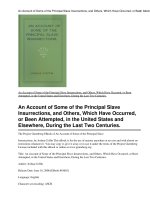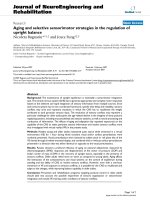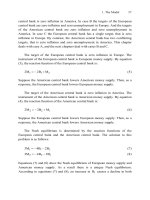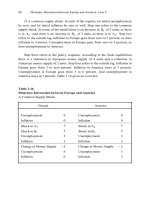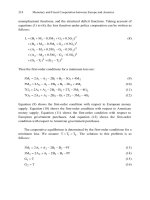Appraisal of antioxidative strategies in the erythrocytes of Marwari sheep during extreme ambiences
Bạn đang xem bản rút gọn của tài liệu. Xem và tải ngay bản đầy đủ của tài liệu tại đây (313.76 KB, 8 trang )
Int.J.Curr.Microbiol.App.Sci (2019) 8(2): 636-643
International Journal of Current Microbiology and Applied Sciences
ISSN: 2319-7706 Volume 8 Number 02 (2019)
Journal homepage:
Original Research Article
/>
Appraisal of Antioxidative Strategies in the Erythrocytes of Marwari Sheep
during Extreme Ambiences
Deeksha1* and Nalini Kataria2
Department of Veterinary Physiology, College of Veterinary and Animal Science,
Rajasthan University of Veterinary and Animal Sciences, Bikaner 334001, India
*Corresponding author
ABSTRACT
Keywords
Marwari Sheep,
Antioxidative
strategies,
Antioxidants, LDH,
G6PDH
Article Info
Accepted:
07 January 2019
Available Online:
10 February 2019
The present investigation was carried out for appraisal of antioxidative strategies in the
erythrocytes of Marwari sheep during moderate, hot and cold ambiences. In each
ambience, animals were categorized as male, female, 6-12 months, 12-18 months and 1824 months. Haemolysates were prepared to determine enzymes of antioxidative strategies.
Enzymes of antioxidative strategies included glucose-6-phosphate dehydrogenase
(G6PDH) and lactate dehydrogenase (LDH). Effect of extreme hot and cold ambiences
was observed on both indicators of antioxidative strategies in the erythrocytes of Marwari
sheep. The mean values of LDH in erythrocytes were significantly (p≤0.05) higher during
hot and cold ambiences as compared to moderate mean value. The mean values were
significantly (p≤0.05) higher in male animals in all the ambiences for G6PDH and was
higher in females for LDH. The mean values of G6PDH in erythrocytes were significantly
(p≤0.05) lower during hot ambience and significantly (p≤0.05) higher during cold
ambience as compared to moderate mean value. Age effect showed a significant (p≤0.05)
increase in the mean values of all the indicators being highest in the sheep of 18-24 months
of age.
oxidative stress, from their role as an oxygen
transporter. Oxygen can be converted to
hydrogen peroxide by superoxide dismutase.
Erythrocytes
with
normal
glucose-6phosphate dehydrogenase (G6PDH) enzyme
activity have higher pentose phosphate
pathway activity compared to G6PDH
deficient RBCs. Erythrocytes are therefore
considered to be the perfect model to study
the oxidative status of the blood because they
are the preferable target of oxidative
modification. Exposure to high concentrations
Introduction
Antioxidative strategies are present inside the
cells in the form of various endogenous
antioxidative enzymes, antioxidants and free
radical scavengers. Imbalance in oxidant
status of the cell can cause oxidative stress
affecting both cellular and biological
damages. Thus, it is reasonable to
counterbalance oxidative stress by modulating
reactive
oxygen
species
production.
Erythrocytes are constantly subjected to
636
Int.J.Curr.Microbiol.App.Sci (2019) 8(2): 636-643
of oxygen radicals, the lack of nucleus and
mitochrondria, inability to synthesise new
protein and degradation of detoxifying
enzymes makes red blood cells uniquely
vulnerable to oxidative stress. The mature
erythrocytes retain an array of enzymes,
proteins, carbohydrates, lipids, anions and
cations, all of which are required in balance,
for effective metabolism and functioning of
the cell. An important consequence of an
imbalance between the erythrocytes’s
components is the poor ability to cope with
oxidative stress, which can result in
degenerative changes in haemoglobin, cell
membrane and enzymes required for normal
erythrocytic function.
antioxidative strategies in the erythrocytes of
Marwari sheep during extreme ambiences.
Materials and Methods
Three hundred and sixty blood samples of
apparently healthy Marwari sheep of both
sexes ageing 6 months to 24 months were
collected from private slaughter houses in and
around Bikaner district, Rajasthan during
moderate, hot and cold ambiences.
Blood samples were collected during
slaughtering. In each ambience 120 blood
samples were collected and the animals were
grouped into male (60) and female (60).
Moderate ambience comprised of OctoberNovember; hot ambience of May and June
and cold ambience of December-January. To
assess the effect of hot and cold ambiences on
the parameters of antioxidative strategies in
the erythrocytes of Marwari sheep, the result
of various parameters analysed was compared
with those analysed during moderate months
serving as control. Following indicators were
analysed to appraise the antioxidative
strategies in erythrocytes:
Analyses of oxidative stress can be useful in
assessing the immune status of the animals
during stress period as reactive oxygen
species are used by the immune system as a
way to attack and kill pathogens. Biochemical
procedures carried out in blood cells are
considered to be minimally invasive
peripheral markers (Gutierrez et al.,
2006).Indicators of oxidative stress allow the
assessment of real status of physiological
defenses and prevention of the appearance of
correlated pathologies (Piccione et al., 2007).
Glucose-6-phosphate
(G6PDH)
Marwari breed of sheep constitutes a major
portion of the sheep population in Western
part of Rajasthan and plays an important role
in the economy of arid and semi- arid tract.
Recurring droughts, low rainfall and scanty
vegetation modulate the physiological
mechanisms of these animals to the extent of
various pathologies. Changes in enzymes
necessary for physiological adjustments are
brought about by great fluctuations in ambient
temperatures during extreme ambiences. The
outcome of long exposure of sheep to extreme
ambiences including extreme hot and cold is
generally the oxidative stress, which does not
show any clinical sign. Therefore, the present
investigation was planned for the appraisal of
dehydrogenase
Lactate Dehydrogenase
Various computer programmes were used to
determine means and standard error
() and analyses
of variance (www.danielsoper.com) to test the
significance of the effects of ambiences, sex
and age groups and correlations (Kaps and
Lamberson, 2004). The changes in the means
were measured by using multiple mean
comparison procedures. For this Duncan’s
new multiple range test was used (Duncan,
1955).
637
Int.J.Curr.Microbiol.App.Sci (2019) 8(2): 636-643
significant (p≤0.05) increase in the mean
values being highest in the sheep of 18-24
months of age. Highly significant (p≤0.01)
sex and age effects were revealed by analysis
of variance.
Results and Discussion
Glucose-6-phosphate
(G6PDH)
dehydrogenase
The mean overall value of G6PDH in
erythrocytes of Marwari sheep during
moderate ambience (control) was 5.00±0.04
U gHb-1. It was obtained from 120 Marwari
sheep irrespective of sex and age. The mean
values of G6PDH in erythrocytes were
significantly (p≤0.05) lower during hot
ambience and significantly (p≤0.05) higher
during cold ambience as compared to
moderate overall mean value (Fig. 1). A
highly significant (p≤0.01) effect of variation
in ambience was also observed by analysis of
variance.
Results corroborated the earlier findings
(Chaturvedi, 2011). Eguinoa et al., (2003)
also suggested higher G6PDH activity in
heifers than bull. Age may change G6PDH
activity (Nesse and Williams, 1998). Ozturk
and Gumuslu (2004) also observed the age
influence on G6PDH activity in rats. Glucose6-phosphate dehydrogenase is a key enzyme
that regulates cellular redox potential. Since
glutathione represents a cellular protectant
against oxidative damage, which inhibits
apoptosis,
These results corroborated the earlier findings
carried out by Chaturvedi (2011) in goats for
G6PDH status in erythrocytes. The lower
concentration of this enzyme in hot ambience
indicated its antioxidant type role which
showed the depletion in an attempt to fight
with free radicals. The enzyme G6PDH is
considered as one of the enzymes associated
with antioxidant defense. Variation in the
activity during hot and cold ambiences
reflected that cells were well equipped to
defend from oxidative insult (Kempel et al.,
1999). Aslan et al., (2005) found that climate
had significant effects on blood G6PDH
levels in lambs. Hot and cold ambiences
probably worked as stressors which initiated
adaptive responses (Kataria and Kataria,
2005). Defense against stress is also
dependent upon G6PDH activity (Ercal et al.,
2002), as stress can depress red blood
corpuscles and leucocyte functions (Roley
and Loegering, 1999). The sex and age effects
were significant (p≤0.05) in moderate,
extreme hot and cold ambiences (Fig. 2). The
mean values were significantly (p≤0.05)
higher in female animals than male animals in
all the ambiences. Age effect showed a
Lactate dehydrogenase (LDH)
The mean overall value of LDH in
erythrocytes of Marwari sheep during
moderate ambience (control) was 30.90±0.11
U gHb-1. It was obtained from 120 Marwari
sheep irrespective of sex and age. The range
of LDH in the present study corroborated the
value given by Yagi et al., (1988) for bovine
and by Chaturvedi (2011) for goat
erythrocytes.
The mean values of LDH in erythrocytes were
significantly (p≤0.05) higher during hot
ambience and cold ambiences as compared to
moderate overall mean value (Fig. 3). A
highly significant (p≤0.01) effect of variation
in ambience was also observed by analysis of
variance. These results corroborated the
earlier findings carried out by Chaturvedi
(2011) in goats for G6PDH status in
erythrocytes. Activity of this enzyme is
known to increase under the condition of
oxidative stress during the lipid peroxidation
process. Subsequently that leads to the
increase level of the lactic acid and lactic acid
salts (Jovanovic et al., 2010).
638
Int.J.Curr.Microbiol.App.Sci (2019) 8(2): 636-643
Fig.1 Mean changes in glucose-6-phosphate dehydrogenase (U gHb-1, G6PDH) overall values in
the erythrocytes of Marwari sheep during extreme ambiences
Fig.2 Mean changes in glucose-6-phosphate dehydrogenase (U gHb-1, G6PDH) values
according to sex and age groups in the erythrocytes of Marwari sheep during extreme ambiences
639
Int.J.Curr.Microbiol.App.Sci (2019) 8(2): 636-643
Fig.3 Mean changes in lactate dehydrogenase (U gHb-1, LDH) overall values in the erythrocytes
of Marwari sheep during extreme ambiences
Fig.4 Mean changes in lactate dehydrogenase (U gHb-1, LDH) values according to sex and age
groups in the erythrocytes of Marwari sheep during extreme ambiences
640
Int.J.Curr.Microbiol.App.Sci (2019) 8(2): 636-643
Techniques
Physical restraint by stockman includes:
• Halter
• Nose grip (fingers or nose tongs)
• Tail elevation
• Skin grip of crural fold
If you do not have a halter or a nose holder the best way to hold a large ruminant is to take a firm
grip of the nostril using the thumb and forefinger of one hand while holding the horn or the ear
with the other hand (Fig. 5).
Fig.5 Nose holder
Haltering large ruminants
Animals need to be halter-trained and this is best done when they are young so that they are
accustomed to the halter.
When a halter is used on an animal talk to the animal to encourage it to move.
Hold the halter no more than 20 cm from the animal cheek and walk close to its neck (Fig.
6).
Fig.6 Haltering large ruminants
Casting or throwing cattle and buffalo
If you do not have a crush and you want to trim the hooves of an animal, it will be necessary for
you to cast (throw down) the animal. To do this you will need:
A halter for the head.
641
Int.J.Curr.Microbiol.App.Sci (2019) 8(2): 636-643
Two people to help you.
Ten to twelve metres of strong rope.
A place where it is safe to throw the animal, where the soil is soft or covered with straw.
First halter the animal then tie the long rope around it as shown in the illustration below. Have
one person to hold the halter while the other joins you and pulls the rope. The animal will
collapse onto the floor and your helper must immediately put his knee on its neck and his hand
on the animal's head to prevent it from rising.
Fig.7 Casting or throwing cattle and buffalo
Do not leave the animal down for a long time as bloat may develop. Remember when casting
animals that both the animal and people can get injured so try to do it safely (Fig. 7).
This could be the probable cause of higher
LDH concentrations during hot and cold
ambiences. The sex and age effects were
significant (p≤0.05) in moderate, extreme hot
and cold ambiences (Fig. 4). The mean values
were significantly (p≤0.05) higher in female
animals than male animals in all the
ambiences. Age effect showed a significant
(p≤0.05) increase in the mean values being
highest in the sheep of 18-24 months of age.
Highly significant (p≤0.01) sex and age
effects were revealed by analysis of variance.
Results corroborated the earlier findings
(Chaturvedi, 2011). Sex and age effect on
serum LDH activity in goats was also
observed
by Kour
(2010).
Lactate
dehydrogenase catalyses the reduction of
pyruvate in glycolytic cycle and is present in
nearly all types of metabolising cells.
M. and Fidan, F. (2005). G6PD,
malondialdehyde and some blood
parameters in lambs in relation to
environment. Indian Vet. J. 82: 145147.
Chaturvedi, M. (2011). Free radical
scavengers and associated analytes in
erythrocytes of Marwari goat during
extreme ambiences. M.V.Sc. thesis in
Veterinary Physiology, college of
Veterinary and Animal Science,
Bikaner and submitted to Rajasthan
University of Veterinary and Animal
Science, Bikaner, Rajasthan.
Duncan, D.B. (1955). Multiple range and
multiple F tests. Biomet. 11:1-42.
Eguinoa, P., Brocklehurst, S., Arana, A.,
Mendizabal, J.A., Vernon, R.G. and
Purroy, A. (2003). Lipogenic enzyme
activities in different adipose depots of
Pirenaican and Holstein bulls and
heifers taking into account adipocyte
size. J. Anim. Sci. 81(2):432-440.
References
Aslan, R., Dundar, Y., Eryavuz, A., Tekerti,
642
Int.J.Curr.Microbiol.App.Sci (2019) 8(2): 636-643
Ercal,N., Aykin-Burns, N., Gurer-Orhan, H.
and McDonald, J.D. (2002). Oxidative
Stress in a phenylketonuria animal
model. Free Radic. Biol. Med.
32(9):906-911.
Gutierrez, L.L.P., Mazzotti, N.G., Araujo,
A.S.R., Klipel, R.B., Fernandes, T.R.G.,
Llesuy, S.F. and Bello-Klein, A. (2006).
Peripheral markers of oxidative stress in
chronic mercuric chloride intoxication.
Braz. J. Med. Biol. Res. 39(6):767-772.
Jovanovic, P., Zoric, L., Stefanovic, I.,
Dzunic, B., Djordjevic-Jocic, J.,
Radenkovic, M. and Jovanovic, M.
(2010). Lactate dehydrogenase and
oxidative stress activity in primary
open-angle glaucoma aqueous humour.
Bosn. J. Basic Med. Sci. 10(1): 83-88.
Kaps, M. and Lamberson, W.R. (2004).
Biostatics for animal science. CABI
Publishing. Oxford shire. pp: 36-270.
Kataria, N. and Kataria, A.K. (2005). A
pscychophysiological
approach
to
alleviate stress in cattle. Indian Cow.
2(6):2-5.
Kempel, L.J., Wang, M., Fei, R., Godwin,
I.R., McFarlane, J.R. and Agar, N.S.
(1999). Erythrocyte metabolism in
foetal sheep. Small Ruminant Res.
34(1):27-31.
Kour, G. (2010). Ambient temperature
associated variations in serum enzymes
and metabolites of hepatic functions in
Marwari
goat.
M.V.Sc.
Thesis
submitted to SK RAU, Bikaner.
Nesse, R.M. and William, G.C. (1998).
Evolution and the origins of disease.
Sci. Am. 279(5):86-93.
Ozturk, O. and Gumuşlu, S. (2004). Agerelated changes of antioxidant enzyme
activities, glutathione status and lipid
peroxidation in rat erythrocytes after
heat stress. Life Sci. 75(13):1551-1565.
Piccione, G., Borruso, M., Giannetto, C.,
Morgante, M. and Giudice, E. (2007).
Assessment of oxidative stress in dry
and lactating cows. Acta Agric. Scand
A. 57:101-104.
Roley, M.J. and Loegering, D.J. (1999). Free
Radic. Biol. Med. 27:1455. (Cited from
Aslan et al., 2005).
Yagi, K. (1988). Glycolytic enzyme activity
and intermediate concentrations in
Theileria sergenti-parasitized bovine
erythrocytes. Jpn. J. Vet. Sci. 50(2):425431.
How to cite this article:
Deeksha and Nalini Kataria. 2019. Appraisal of Antioxidative Strategies in the Erythrocytes of
Marwari Sheep during Extreme Ambiences. Int.J.Curr.Microbiol.App.Sci. 8(02): 636-643.
doi: />
643

